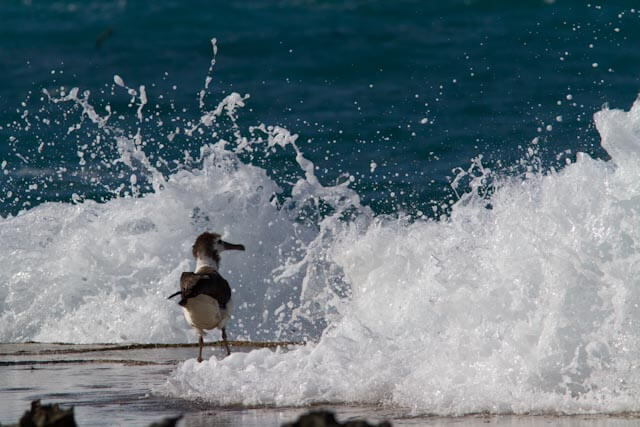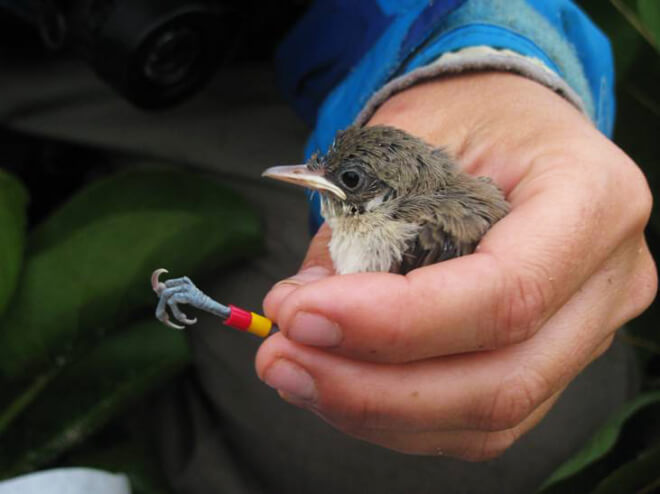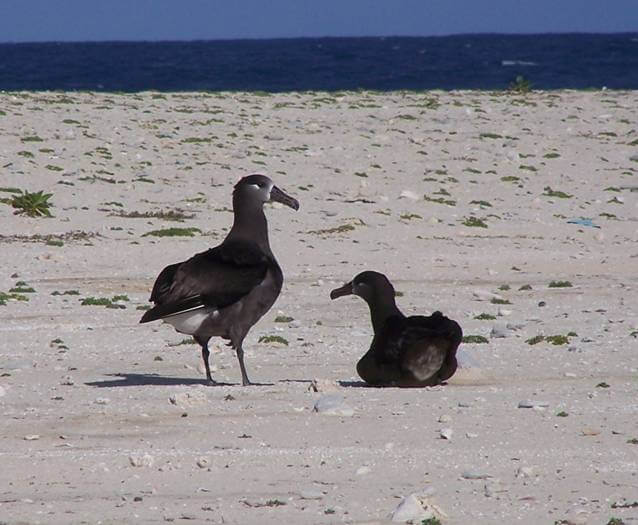A Tubenose's First Milestone: Facing the Air and Sea
July 5-21, 2014 | By Robby Kohley
Millerbird Update: We have been on Laysan for three weeks, and with camp establishment, familiarization, and general training behind us, we have settled into a daily routine that focuses on population monitoring of Millerbirds.
We are just getting started but we are already excited about our initial discoveries. We have seen 73 of the 109 banded birds known from the end of the last monitoring season in September 2013. We expect this number to continue to grow as we investigate more areas.
I participated in the pre-translocation work on Nihoa in 2009 and 2010, as well as both translocations and post-release monitoring periods in 2011 and 2012, so the initial founder birds are of particular interest to me. Because of the time spent working and cheering for them, many feel like old friends. In just a short time we have already seen 25 of the 50 original founders and expect to find more.
These founding individuals continue to expand our understanding of Millerbird biology as they repopulate Laysan, with some possibly setting new longevity records for the species. Megan, Barbara, and I are excited to continue the search for more Millerbirds, and share the results in the future.
Coming of Age on Laysan: Albatross Chicks Take First Flight to Sea
One of the motivations for a biologist to keep returning to work on the small island of Laysan is that no matter what time of year, there is some type of exciting natural history spectacle to appreciate. This month has been no exception, with the fledging Laysan and Black-footed Albatrosses putting on a stirring show.
The albatross parents have spent 290 days, flown an estimated 50,000 combined miles, and avoided the many perils of the open ocean to get the young albatrosses to this milestone in their life—their first flight.
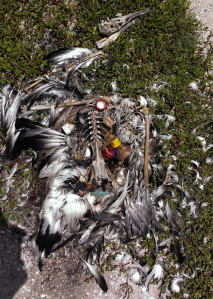
An unfortunate example of the effects of being fed plastic on a young albatross. Photograph by Barbara Heindl
Unfortunately some of the perils of the open ocean that the adults must overcome in order to successfully raise young include dangerous human-made obstacles. These include thousands of hooks placed out by the long-line fisheries, which can snare and drown birds, and tons of small pieces of plastic floating on the surface of the ocean, which can be ingested directly or indirectly due to their resemblance or association with the birds' primary food sources. The plastic can gravely affect the adults or be passed on to the young during feeding, causing death due to choking, starvation, or dehydration.
The next step is one the young albatrosses must take on their own, with no guidance from the adults, and it is a big step! They must learn to fly while safely navigating the crashing waves and avoiding the tiger sharks that have gathered just off-shore to gulp down any unlucky albatross that spends too much time sitting on the water. Immediately upon learning to fly, they must travel hundreds of miles to their central feeding grounds in the far North Pacific. This could be compared to a toddler learning to walk and immediately being made to run a marathon in order to get lunch.
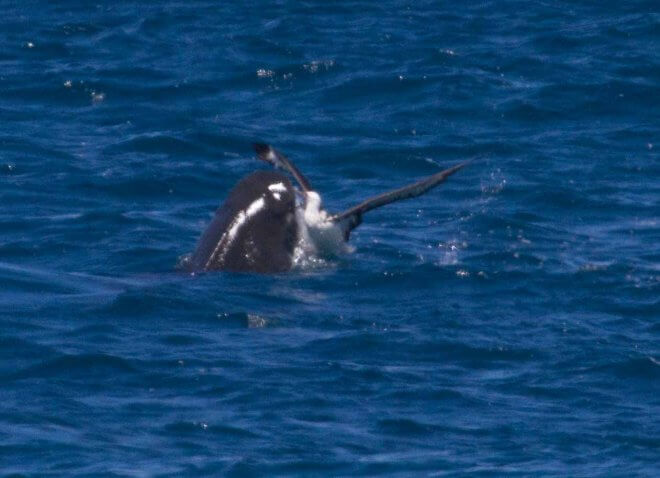
Shark attacking an unlucky young albatross that will not be making it to the far North Pacific. Photo by Robby Kohley
Observing the fledging process is a captivating lesson in animal behavior and the pragmatism of nature. For young albatross, where on the island they hatch and then decide to practice flying can mean the difference between failure and success.
Practice Makes Perfect—If You're Lucky!
Some individual young albatross practice flying at the South Ledge, which is characterized by crashing waves. Many become caught up by the waves on their first attempt, and with no easy way to escape they quickly become overwhelmed. If they do escape there is a decent chance they are injured or have used up too much energy and burned precious fat reserves that will be needed to make it north. Others, by fortunate circumstance, end up practicing on the inland lake or the calmer bays on the island. These areas allow for many short practice flights, better muscle development—and more second chances!

A young Laysan Albatross recovers from being caught in the spin-cycle of the waves. Photo by Robby Kohley
While watching the young albatrosses it is hard not to feel empathy for their situation as they struggle in the waves, crash land while practicing to fly, or stand on shore staring out to sea over the breaking waves and tiger sharks, toward the horizon knowing their future is that way, with no idea what to expect.
It is easy for a person to identify a time in their life when they were in comparable circumstances, when maybe you faltered while learning, failed because you weren't prepared, or faced a big change or decision in your life with no idea what the future may hold.

A young Laysan Albatross overcomes the odds and heads for the far North Pacific. Photo by Robby Kohley
This is why when you see a young albatross overcome it all and disappear over the horizon, it is hard not to crack a smile, wish him well—and want to warn him of the perils of fishhooks and floating plastic that await him.
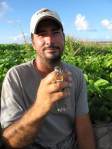 Robby Kohley has worked on conservation projects throughout the Hawaiian Islands since 2007, most recently for the Kauai Forest Bird Recovery Project on their efforts to protect the endangered Akikiki and Akeke'e. While on Laysan he hopes to capture photos of fledgling albatross and furtive Millerbirds. On his off-time, he enjoys killing black flies, stashing candy bars and sun bathing.
Robby Kohley has worked on conservation projects throughout the Hawaiian Islands since 2007, most recently for the Kauai Forest Bird Recovery Project on their efforts to protect the endangered Akikiki and Akeke'e. While on Laysan he hopes to capture photos of fledgling albatross and furtive Millerbirds. On his off-time, he enjoys killing black flies, stashing candy bars and sun bathing.





































